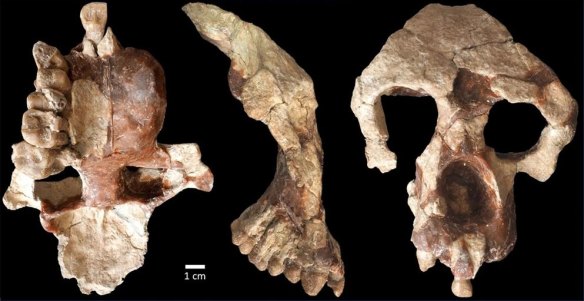By Sarah Knapton
London: Africa has always been considered the cradle of mankind, where humans evolved from apes on the continent before spreading to the rest of the world.
An intriguing find is challenging the long-standing assumption.
The partial skull of a new ancient ape has been discovered in Turkey, and it appears to predate African apes, suggesting that human origins may actually lie in Europe.

A new face and partial brain case of Anadoluvius turkae – a find that may have changed how we understand humanity to have evolved.Credit: Sevim-Erol, A., Begun, D.R., Sozer, Ç.S. et al
The fossil of Anadoluvius turkae was discovered in Cankiri, a city about 138 kilometres north-east of Ankara, and is thought to date from about 8.7 million years ago.
In contrast, early hominins – the group that includes chimpanzees, bonobos, gorillas, humans, and their fossil ancestors – were not seen in Africa until about 7 million years ago.
It suggests that the ancestors of African apes and humans evolved in Europe before migrating south between 9 million and 7 million years ago.
“Our findings further suggest that hominins not only evolved in western and Central Europe but spent over 5 million years evolving there and spreading to the eastern Mediterranean before eventually dispersing into Africa, probably as a consequence of changing environments and diminishing forests,” said Professor David Begun from the University of Toronto’s anthropology department.
“These findings contrast with the long-held view that African apes and humans evolved exclusively in Africa,” Begun said.
“This new evidence supports the hypothesis that hominins originated in Europe and dispersed into Africa along with many other mammals between 9 [million] and 7 million years ago, though it does not definitively prove it.
“For that, we need to find more fossils from Europe and Africa between 8 [million] and 7 million years old to establish a definitive connection between the two groups.”
The well-preserved skull was uncovered in 2015, but experts are only now realising its true significance.
Researchers believe Anadoluvius was close to the size of a female gorilla – about 75 kilograms – lived in a dry forest setting, and probably spent a great deal of time on the ground.
Alongside the skull in the same fossil layer, experts found evidence of giraffes, warthogs, rhinos, diverse antelopes, zebras, elephants, porcupines, hyenas, and lion-like carnivores.
All animals commonly associated with African grasslands and dry forests today.
Experts believe this ecological community dispersed into Africa from the eastern Mediterranean sometime after about 8 million years ago.
“The founding of the modern African open country fauna from the eastern Mediterranean has long been known and now we can add to the list of entrants the ancestors of the African apes and humans,” said Professor Ayla Sevim Erol, of the Department of Anthropology, at Ankara University, Turkey.
“We have no limb bones, but judging from its jaws and teeth, the animals found alongside it, and the geological indicators of the environment, Anadoluvius probably lived in relatively open conditions, unlike the forest settings of living great apes.
“More like what we think the environments of early humans in Africa were like. The powerful jaws and large, thickly enamelled teeth suggest a diet including hard or tough food items from terrestrial sources such as roots and rhizomes.”
The researchers say that the findings establish Anadoluvius turkae as a branch of the part of the evolutionary tree that gave rise to chimpanzees, bonobos, gorillas, and humans.
The line that would lead to humans diverged from apes at some point between about 9.3 million and about 6.5 million years ago.
However, not all experts are convinced and say the findings do not change the theory that the first humans evolved in Africa before spreading further afield.
Professor Chris Stringer, research leader in human evolution at the Natural History Museum in London, said: “This has been a long-running debate regarding the great ape and our origins.
“I don’t think this find changes much from the discussions (in a recent paper in the journal Science) which concluded: ‘Current evidence suggests that hominins originated in Africa from Miocene ape ancestors unlike any living species’.”
The research was published in the journal Communications Biology.
The Telegraph, London
Get a note directly from our foreign correspondents on what’s making headlines around the world. Sign up for the weekly What in the World newsletter here.